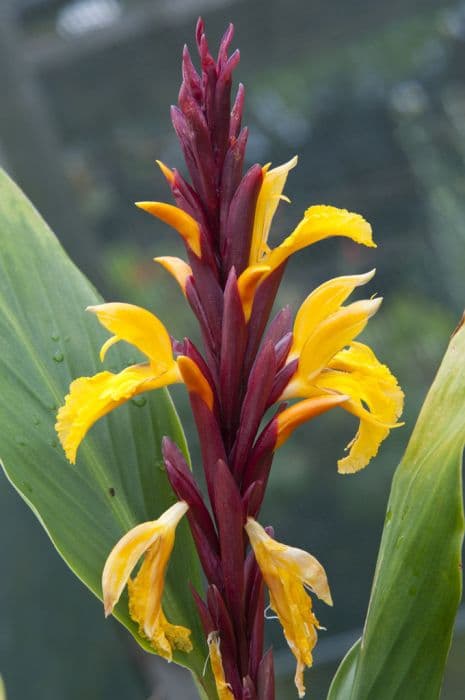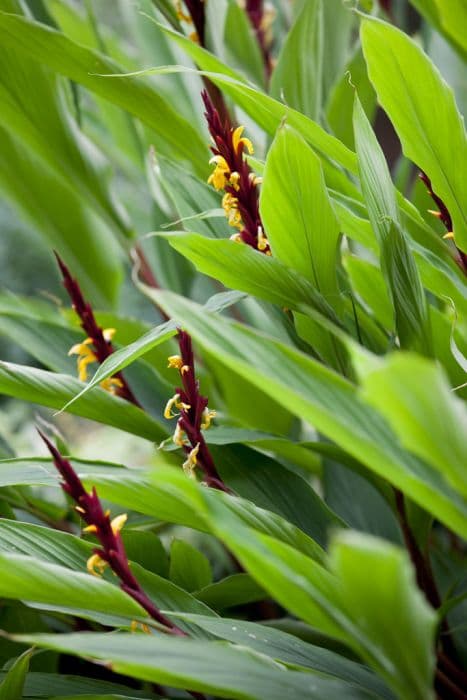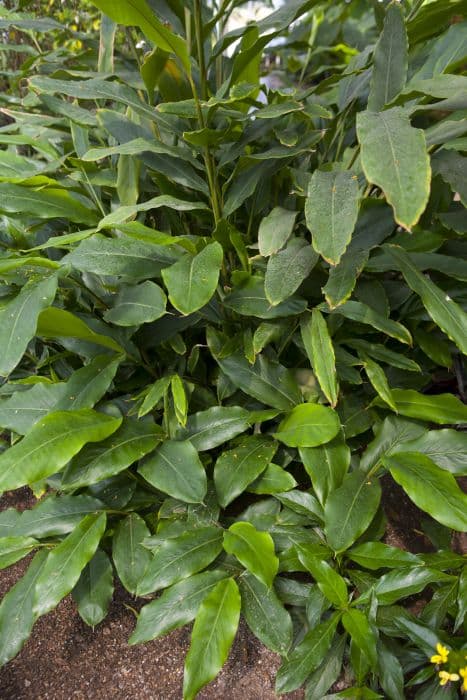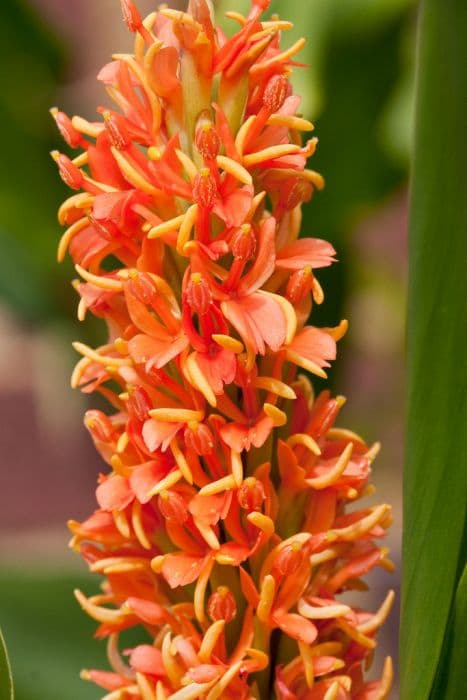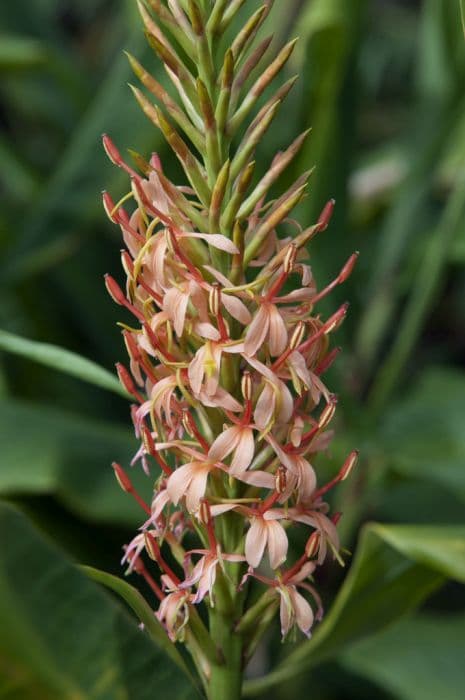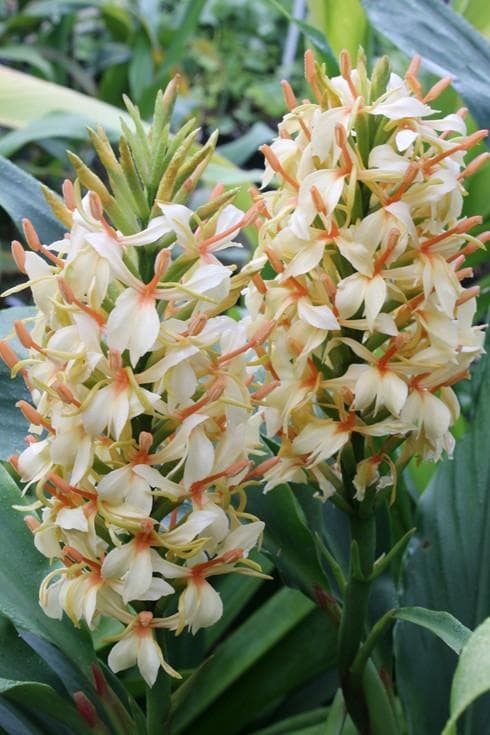Roscoea Roscoea wardii

ABOUT
The plant commonly known as Roscoea wardii showcases a striking aesthetic with its lush green foliage and attractive flowers. The leaves are elongated, resembling straps, and grow in a spiraling pattern around the stem, giving the plant a full and verdant appearance. During the blooming season, the flowers emerge with a delightful display. They possess a sophisticated beauty, often presenting in shades that may vary from a soft pale lavender to a deeper purple hue. The petals have a delicate, yet robust quality, with the upper petals arching over like a hood protecting the plant's inner reproductive structures, while the lower petals may fan out to create an inviting landing platform for pollinators. These flowers typically grow in clusters, and their trumpet-like structure is both elegant and eye-catching, with a certain depth and complexity that may include subtle hints of contrasting coloration, such as a lighter throat or darker spots and markings. The overall visual impact of Roscoea wardii is one of exotic charm and grace, making it a cherished addition to any garden where it fits within the growing conditions it prefers.
About this plant
 Names
NamesFamily
Zingiberaceae
Synonyms
Ward's Roscoea
Common names
Roscoea wardii
 Toxicity
ToxicityTo humans
Roscoea wardii, commonly known as Hardy Ginger, is not widely documented for its toxicity to humans. There are no known toxic effects reported from ingesting or coming into contact with this plant. As with any plant, individual allergies or sensitivities are possible, but Hardy Ginger is generally considered non-toxic to humans.
To pets
Hardy Ginger, or Roscoea wardii, is also not reported to be toxic to pets. There is no substantial evidence to suggest that ingestion of any part of this plant causes poisoning in common household pets. Owners should still be cautious as animals can have individual reactions or sensitivities to plant materials that are not typically toxic.
 Characteristics
CharacteristicsLife cycle
Perennials
Foliage type
Deciduous
Color of leaves
Green
Flower color
Purple
Height
1 foot (30 cm)
Spread
0.5 feet (15 cm)
Plant type
Herb
Hardiness zones
6
Native area
Himalayas
Benefits
 General Benefits
General Benefits- Ornamental Value: Roscoea wardii, commonly known as Hardy Ginger, adds aesthetic value to gardens with its attractive flowers and foliage.
- Low Maintenance: Hardy Ginger is known for requiring minimal care, making it suitable for gardeners of all levels.
- Pollinator Attraction: The plant's flowers can attract bees, butterflies, and other beneficial pollinators to the garden.
- Drought Tolerance: Once established, Roscoea wardii can tolerate periods of dryness, reducing the need for frequent watering.
- Cold Resistance: Hardy Ginger is more cold-resistant than other tropical plants, allowing it to survive in cooler climates.
- Compact Growth: With its compact size, it is well-suited to smaller gardens or as a border plant.
- Soil Adaptability: It can adapt to a range of soil types, provided they are well-draining.
- Shade Tolerance: Roscoea wardii can perform well in partial shade, offering flexibility in garden design.
- Versatility: It can be used in various landscape designs, including rock gardens, woodland settings, and traditional flower beds.
 Medical Properties
Medical PropertiesThis plant is not used for medical purposes
 Air-purifying Qualities
Air-purifying QualitiesThis plant is not specifically known for air purifying qualities.
 Other Uses
Other Uses- Roscoea wardii, commonly known as the hardy ginger, can be used in garden design for its striking orchid-like flowers which add an exotic touch to temperate gardens.
- The plant has potential as a natural dye source, where the roots might be used to obtain color for textiles or crafts.
- The hardy ginger may be used in plant breeding programs to develop new ornamental varieties with unique characteristics.
- Some cultures might consider using the leaves of Roscoea wardii for decorative purposes in floral arrangements or as part of cultural rituals.
- The fibrous roots can be researched for their suitability in making small handicrafts or as a component in the creation of bio-composite materials.
- Fresh or dried flowers of the hardy ginger could be used in potpourri mixtures for their shape and potential fragrance.
- Roscoea wardii's architectural foliage might be used as a natural backdrop in photography to create lush green scenes.
- The entire plant, when dried, could potentially be used in creating botanical prints or used in the art of herbarium specimen preparation.
- In colder climates, the hardy ginger, due to its resilience, could be utilized in educational demonstrations on how tropical-appearing plants can be grown in non-tropical regions.
- It may also be used in culinary presentations, with the blooms providing an edible garnish, assuming they are non-toxic and have been grown without harmful pesticides.
Interesting Facts
 Feng Shui
Feng ShuiThe plant Roscoea wardii is not used in Feng Shui practice.
 Zodiac Sign Compitability
Zodiac Sign CompitabilityThe plant Roscoea wardii is not used in astrology practice.
 Plant Symbolism
Plant Symbolism- Resilience: Roscoea wardii, commonly known as Hardy Ginger, grows in the mountainous regions of the Himalayas, signifying its ability to thrive in harsh conditions and symbolize resilience.
- Rarity: Hardy Ginger is not a common garden plant, and due to its specific environmental requirements, its rarity can symbolize uniqueness or something treasured.
- Exotic Beauty: As a member of the ginger family, the plant's exotic look with its striking, orchid-like flowers can symbolize foreign or unique beauty.
- Grounding: Gingers are known for their strong roots, and Hardy Ginger can symbolize being grounded or having a solid foundation.
- Healing: Many gingers have medicinal properties, and while it's not as well-known for this, Hardy Ginger may symbolically represent healing or therapeutic qualities.
 Water
WaterThe Roscoea wardii, commonly known as Hardy Ginger, requires consistent moisture during its active growing season, which is spring and summer. It should be watered thoroughly whenever the top inch of soil feels dry to the touch. Typically this might mean watering once or twice a week depending on the climate and weather conditions. It is important not to overwater as this can lead to root rot. Provide approximately half a gallon for a medium-sized pot each time you water, ensuring even distribution across the soil.
 Light
LightHardy Ginger prefers partial shade with protection from harsh afternoon sun. The ideal spot for this plant is in an area that receives dappled sunlight or light shade for most of the day. Direct morning sunlight is acceptable, but avoid intense direct sunlight in the afternoon to prevent scorching the leaves.
 Temperature
TemperatureHardy Ginger thrives in temperatures between 60 and 75 degrees Fahrenheit. It can tolerate a minimum temperature of around 50 degrees Fahrenheit, but should not be subject to freezing conditions. The maximum temperature for healthy growth should not exceed 80 degrees Fahrenheit. These temperature preferences make it ideal for cultivation in temperate climates.
 Pruning
PruningPrune the Hardy Ginger to remove dead or damaged foliage and to encourage bushier growth. This is best done after the blooming period in late summer or early fall. Cut back the stems that have finished blooming, and if necessary, you can also prune in spring to shape the plant. Pruning should be gentle and not more than one-third of the plant should be removed at one time.
 Cleaning
CleaningAs needed
 Soil
SoilThe Himalayan ginger thrives in fertile, well-draining soil with abundant organic matter. Aim for a pH of 6.5 to 7.5. A mix containing loam, peat, and sand is ideal to retain moisture yet allow excess water to drain.
 Repotting
RepottingHimalayan ginger should generally be repotted every 2 to 3 years. The best time for repotting is in the spring as the plant emerges from dormancy.
 Humidity & Misting
Humidity & MistingHimalayan ginger prefers high humidity levels, ideally between 60% to 70%. This replicates their natural humid habitat, aiding their growth and flower production.
 Suitable locations
Suitable locationsIndoor
Use well-draining soil, place in indirect light, and maintain high humidity.
Outdoor
Partial shade location with rich, well-drained soil and sheltered from strong winds.
Hardiness zone
6-9 USDA
 Life cycle
Life cycleRoscoea wardii, commonly known as ginger lily, begins its life cycle as a seed which upon germination grows into a small seedling. With favorable conditions of moisture and light, the seedling will further develop into a young plant, producing narrow, lance-shaped leaves. During its vegetative growth stage, it forms a rhizome underground, which stores energy and allows the plant to survive adverse conditions. The ginger lily then enters its reproductive phase, flowering in summer to early autumn with distinctive purplish flowers that attract pollinators for sexual reproduction. After pollination, the plant produces capsules containing seeds which, when mature, are dispersed to give rise to new plants. During winter, the aerial parts of the plant die back to the rhizome, entering a period of dormancy before resuming growth in the next spring.
 Propogation
PropogationPropogation time
Spring-early summer
The most popular method of propagation for Roscoea wardii, commonly known as Hardy Ginger, is through division. This method is typically carried out in the spring just before new growth begins. A mature clump of the plant is carefully dug up and the rhizomes are gently teased apart, ensuring that each division has at least one growth bud. The divisions are then replanted in well-drained soil at a depth of about 1 to 2 inches (2.5 to 5 centimeters). It's critical to keep the newly planted divisions well-watered but not waterlogged to promote successful establishment and growth.
